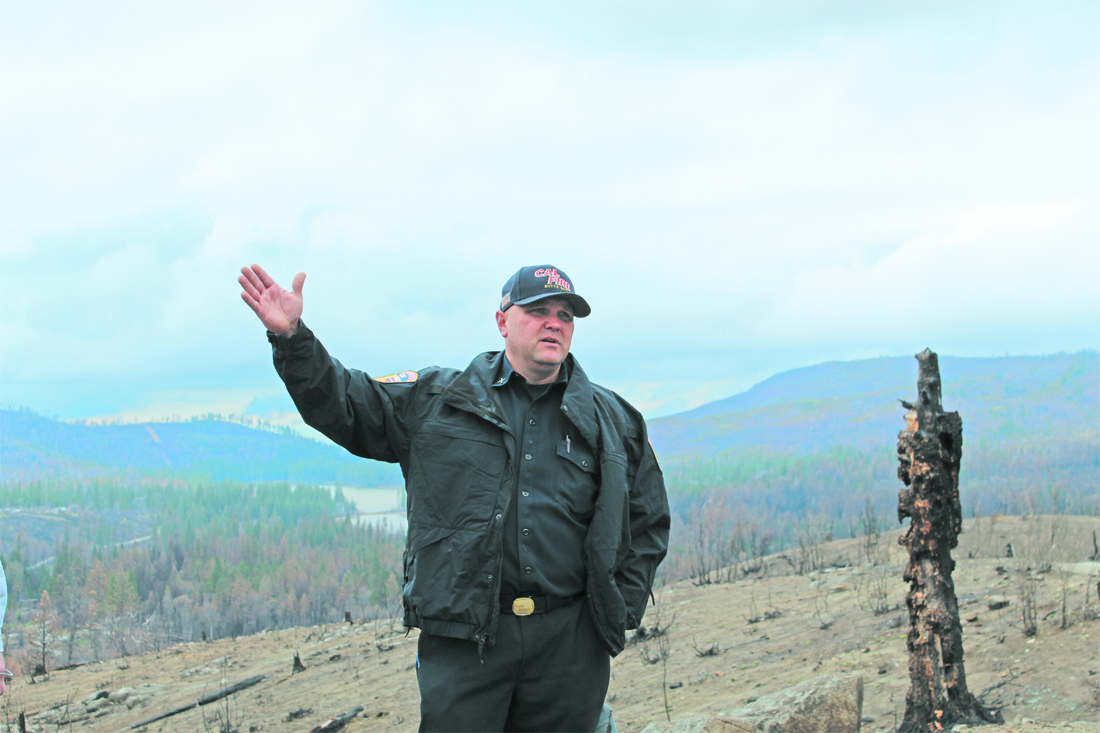
Photo by Meredith J. Cooper
Cal Fire’s Gus Boston is spearheading several forest management projects, including one in Concow.
Several things became clear early on during last week’s Wildfire Safety Planning Summit in Paradise. Among them: A ton is being done right now to plan for the future of Butte County’s forests, and many groups are working together to make them happen.
That’s not always been the case.
During a forest health tour through Concow in April, coordinated by the Butte County Fire Safe Council, representatives of several agencies—Cal Fire, the U.S. Forest Service, local parks districts—lamented the lack of cohesion when it comes to forest management. With a checkerboard of ownership and a variety of interests—from living on the land to logging to preserving the environment—putting together a plan that both protects the landscape from further catastrophes and makes everyone happy is extremely challenging.
It appears the tides are beginning to turn, however.
“As a landowner agency, we’re more fragmented than a checkerboard,” Jeremy Straight of the Bureau of Land Management (BLM) told the room full of attendees. The summit, held Friday (Dec. 6) and organized by the fire safe council, aimed to bring all interested agencies together for status updates, as well as some foreshadowing of future projects. “We’re trying to find where other treatments are being implemented and connect those dots.”
Straight pointed to a project in Forbestown headed by Gus Boston, Cal Fire battalion chief of vegetation management, as an example of agencies working together. BLM owns about 100 acres in the area and is coordinating with Cal Fire on a management plan. Likewise, Cal Fire is working with private landowners to do prescribed burns and further reduce fuels. Boston is overseeing projects in the Cohasset and Concow areas as well.
“The spirit of the Camp Fire has made us all work together more with the challenges we face,” Calli-Jane DeAnda, executive director of the fire safe council, told the CN&R.
“Cal Fire’s vegetation management program is a game-changer,” she added. “Those types of projects weren’t happening five years ago.”
While Butte County has long had a unified community wildfire preparedness plan (CWPP)—a collaboration of fire agencies—a lot of other land-owning entities have tended to work on their own, creating individual strategic plans. That’s no longer going to cut it, several of Friday’s speakers agreed.
“We do a lot of planning, but we’ve never had a countywide vision of forest health,” Wolfy Rougle, conservation projects coordinator for the Resource Conservation District of Butte County, told those assembled. “Over time, state agencies are going to be interested in giving more funding to counties and regions that are working collaboratively.”
Rougle highlighted the Wildlands Task Force that emerged after the Camp Fire as a good example. It’s a collaboration between her organization and the local fire safe councils. One of its main goals is to create a forest restoration plan, one that doesn’t call only for reforestation.
“The consensus is the next forest, in order to be fire- and climate-resistant, needs to be less dense than the forests we’ve come to know in the 20th century. Less dominated by pines, more by oaks,” she said. “That’s the kind of restoration that we want to help deliver to people.”
One project that has the potential to further aid cooperation among agencies and landowners is a data portal sponsored by the Sacramento River Watershed Program and developed by Truckee-based tech company 34 North. The first of its kind, it’s a mapping tool that incorporates fire history, project tracking, topography and even specifics as small as tree height.
“We’re bringing together all resources in one place … so people can start communicating across boundaries,” said Amye Rita Osti, CEO of 34 North. “We collect information you might need for grants.”
The data portal is an exciting development because it incorporates project info from multiple agencies, Osti said. So you can log on and find out what kind of fuel reduction is being done in Concow and where it stops, for instance. It also includes real-time conditions collected from sensors throughout the region.
Ali Meders-Knight, representing the Mechoopda Indian Tribe, talked about a project to emphasize traditional ecological knowledge (TEK) into local forest management. It was a priority listed in the 2018 Farm Bill, one that extended its conservation stewardship program to 20 years. Because the Mechoopda’s ancestral land encompasses much of Butte County, the tribe is looking to incorporate practices such as prescribed burns and educate people about native plants and forest management from a holistic perspective.
“We’re looking at the ecological end results within 20 years,” Meders-Knight said. “Wildfire risk mitigation, fuel reduction … watershed restoration, aquifer recharge, restoration of native ecosystems.”
The final presenter of the day was Tracy Hruska, from the Sierra Institute, a newcomer to the region with a base in Taylorsville. His organization, a nonprofit, plans to fund innovative projects that aid the deforestation effort in the Sierra Nevada Conservancy region, which encompasses 25 million acres ,including parts of Butte County.
“The problem with overforestation is it’s expensive to deal with,” Hruska said. “You get a lot of slash piles, and the wood tends to get burned in place. Then you’re not recovering any costs. But there are products that can come out of this—firewood, chipping, biomass.”
He highlighted some projects implemented elsewhere, like a biomass boiler system that heats an entire building in Quincy, or pellet chippers that can create fuel for home wood stoves.
“We want to increase the ability of rural communities to do good work and contribute to forest management,” he continued. “It’s a lack of forest management that’s gotten us here.”
